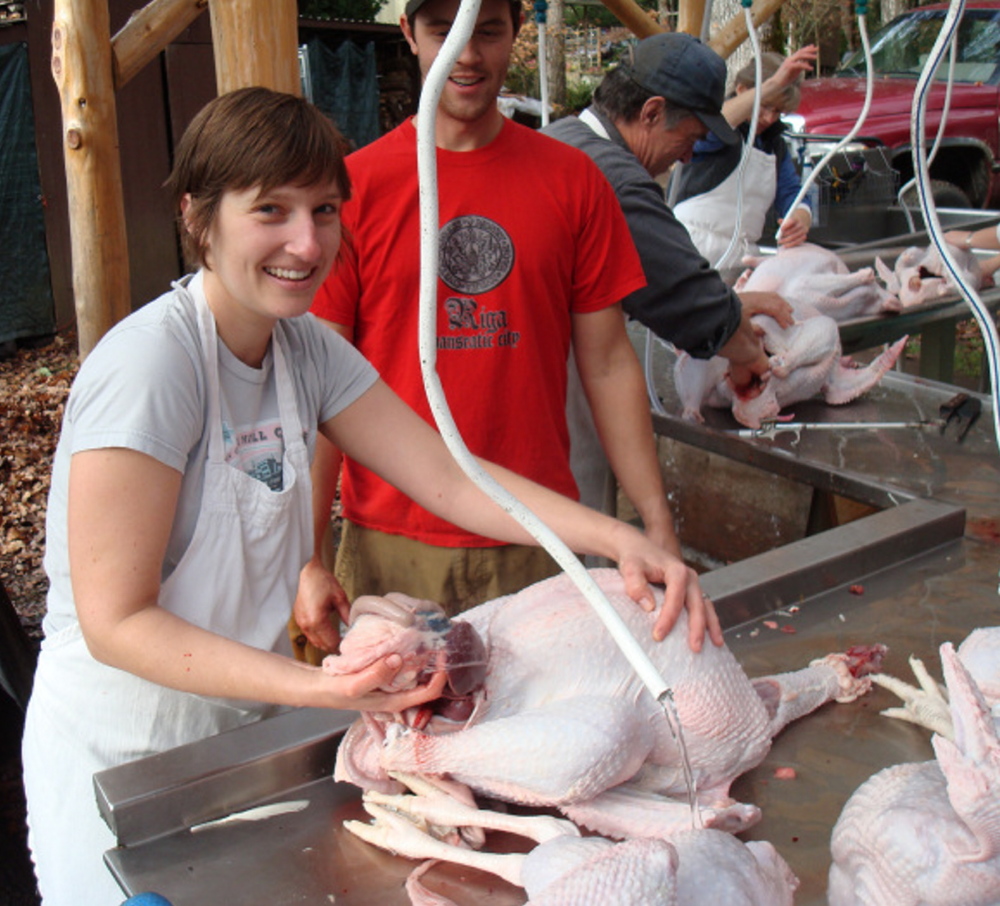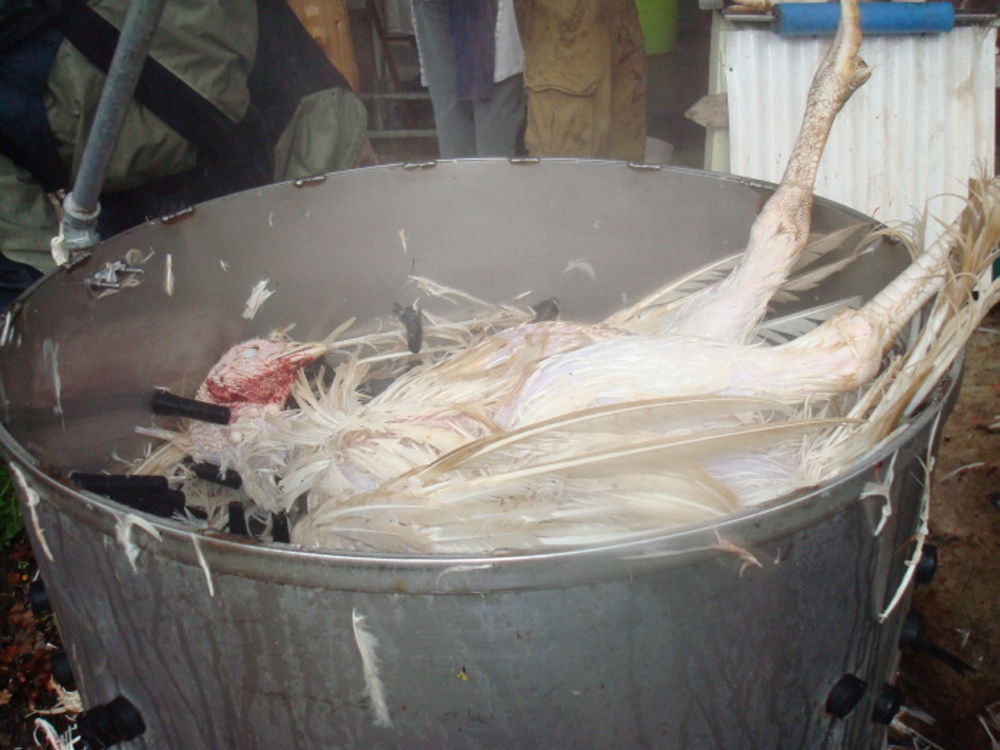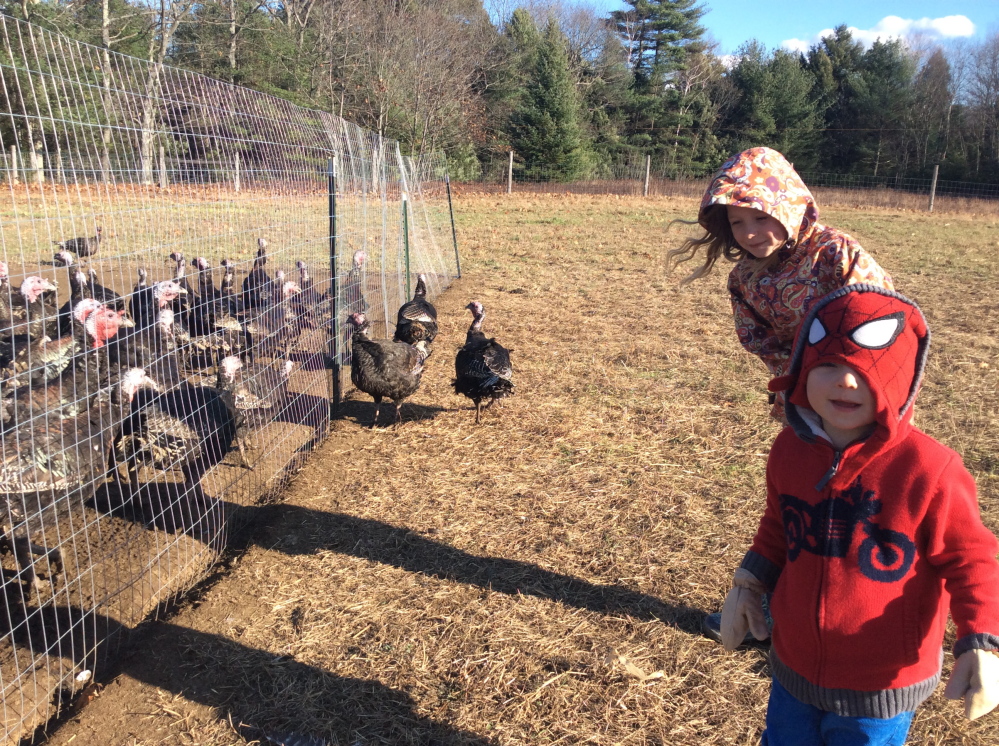Soon after we moved cross-country to Oregon in fall 2008, I had a defining “Portlandia” experience: I hand-selected, “helped” slaughter and eviscerated our first free-range Thanksgiving turkey, which I’d watched contentedly scratch and peck just minutes earlier on the outskirts of our college town of Corvallis, at a new farm started by a young hipster farmer.
It was our first time hosting Thanksgiving as a newly married couple, and our first time buying, dry-brining with an herbed salt rub and roasting the big bird for my parents and sister, who were visiting from Virginia.
Once you go local, free-range (perhaps heritage breed?) and freshly slaughtered turkey, it’s hard to turn back, despite the expense. I’d made the mistake of selecting a whopping tom weighing in at 26.8 pounds, which meant we ate a lot of frozen and defrosted Vietnamese turkey pho soup, Mexican turkey tortilla soup and Spanish turkey picadillo in the ensuing months.
It was the most delicious turkey we’d ever had, but even more significant than its taste was how participating in its slaughter, and not averting our eyes from that gore, imbued that first Oregon Thanksgiving with a renewed spirit of reverence.
I lacked the courage to dispatch our bird myself, but I bore witness as the Afton Field farmer thrust my chosen turkey head-first down the aluminum-coned chute and gave it a swift blow to the neck, killing it. It resembled the pain-minimizing kosher or halal way that Jews and Muslims, respectively, have ritually slaughtered livestock for meat for thousands of years.
For our subsequent Thanksgivings in Oregon, we sprang for leaner heritage breeds with succulent dark meat that cooked down into elixir-like stock. They put us in mind of wild turkey, which I’ve never tried, though we’ve joked about hunting one of the quite tame ones that are plentiful there and here in Maine.
My 3-year-old, Theo, was just 5 months old his first Thanksgiving in Oregon, which was also our last before relocating back East. He still sucked breast milk and wasn’t yet ready for solid foods like turkey. That next spring though, he did gnaw on whole pastured chicken feet (also from Oregon’s Afton Field Farm) that I boiled down into chicken stock for matzo ball soup for Passover.
In Maine, we took great pains to procure local turkey, first from Wolfe’s Neck Farm in Freeport and last year from Milkweed Farm just down the road in Brunswick. Since Thanksgiving coincided with Hanukkah last year, I also fried up a big batch of Maine potato latkes in lard I’d rendered from the half-pig we’d also ordered from Milkweed Farm. (Jews traditionally eat fried food for Hanukkah to celebrate the miracle of oil that burned in the temple for eight days after the Maccabean Revolt, even though there was only enough for a single day.)
When I served these “lardkes,” one of our guests, invoking “The Simpsons,” declared them “sacrilicious.” But I felt reverent as we listened to our dozen guests, crowded around the outdoor picnic table we’d brought inside, each share what they were grateful for that year.
The Jewish-Thanksgiving fusion-food “lardkes” reflected my own version of ethical eating, using local and seasonal lard that would otherwise go to waste instead of quarts of expensive oil shipped in from afar. To me, they tasted of tradition and terroir.
This year, though, we’ll be served a different kind of turkey, a traditional fresh, thankfully not frozen, kosher one, when we travel to my husband’s aunt’s house in Westchester, New York, to celebrate Thanksgiving with a record 36 relatives. Since Aunt Judy keeps a kosher kitchen, we can’t bring in any food, save wine from Tess Market in Brunswick, including an Oregon pinot noir for nostalgia’s sake, and chocolates. Fundraiser pies that we and other relatives wanted to bring were politely – and regrettably – declined.
“You are so sweet to want to bring pies,” emailed Aunt Judy, who is baking pumpkin pies, pecan pies and apple crisps herself in addition to the full Thanksgiving spread. “Unfortunately, we have a kosher house, and I can’t be sure of ingredients or where/how the pies were prepared.”
Aunt Judy is bending the rules to allow butter-based desserts (her sister’s New York cheesecake), served on rented nonporous glass dishes, and only after the meat courses are cleared. “It’s not Passover, after all,” she said; she feels a lot more pressure on that Jewish holiday with its stringent food rules. At dessert, Aunt Judy also will serve buttered pecans that invoke my Southern childhood in Richmond, Virginia.
Ever the matchmaker, Aunt Judy aligned the stars for me to meet my husband Dan when we both lived in New York. This Thanksgiving, we’ll express gratitude for Aunt Judy’s instincts, without which our Theo wouldn’t exist, and Dan and I wouldn’t be building year-round lives together here in Maine, my family’s longtime place of summer refuge.
So we’re off the hook for Thanksgiving menu planning, but I do find myself missing the autumn ritual of ordering our turkey from a local farm. Last week, my son Theo and I consoled ourselves by visiting the 90 squawking, wing-flapping, frantic turkeys (as if sensing their impending doom) at Milkweed Farm, as the farm family’s youngest son, Daire’ Woodruff, chased them round their pen. The dark Broad Breasted Bronze turkeys looked wild, the toms puffing up their plumes to protect themselves against attack – and the cold.
“I hate turkeys,” Daire’ said. Just 6 years old, he already has a farmer’s equanimity towards life. “I’m not sad at all if they die.”
We will at least enjoy a locavore vegetarian feast the Bowdoin Food Co-op sustainable cooking club students prepare on Monday. These students regularly gather to prepare and share local, sustainable food for 20 on a $70 budget. For this pre-Thanksgiving feast, the college has given them a little more, $100, to spend at the Brunswick Winter Market at Fort Andross, supplemented by campus garden pumpkins, parsnips and potatoes.
And despite our differing conceptions of kosher, we share our interest in local food with Aunt Judy and Uncle Jeff, who tend an extensive vegetable garden, planted a food bank garden at work and had a CSA (community supported agriculture) share that included organic produce from Adamah Farm at the Isabella Freedman Jewish Retreat Center in Connecticut.
We’re ready to fall back on the easy familiarity of family this season, and share the good food we can all rally around. And, to be frank, I am thankful to take a back seat on all procuring and preparing, to be more present and less preoccupied in the kitchen, this Thanksgiving.
LARD LATKES (‘LARDKES’)
I got this recipe from Marisa McClellan’s popular “Food in Jars” blog (go to foodinjars.com and search for “latkes”). Her recipe reflects our shared half-Ashkenazi Jewish/half-Scottish-ish heritage.
Wanting to keep her latkes local, McClellan describes how she came to make this “decidedly un-Kosher choice. I cooked them in local lard. It was the best local cooking medium I had (I considered clarifying some butter, but could not find the time) and honestly, they were some of the most crisp and celebratory latkes I’ve ever made.”
Amen. My guests last year concurred. McClellan recommends using 2 to 3 tablespoons of lard per batch for latkes that are crispy on the outside and tender (and fully cooked) within.
But last year, I went whole hog and deep-fried my “lardkes” in a cast-iron pan, fully submerged in cups of melted, bubbling lard.
3 small to medium Yukon gold potatoes
1/4 of a very large yellow onion, grated
1 egg
4 tablespoons all-purpose flour
Salt and pepper
2 to 3 tablespoons lard per batch
Sour cream and applesauce (preferably homemade), for serving
Grate the potatoes and wring the liquid out. (McClellan says the secret to good latkes is squeezing as much moisture out as possible. I weigh down the grated potatoes in a colander set in a bowl to collect the white potato starch that settles at the bottom, and then I add this paste to the batter as binder. McClellan wraps the grated potatoes in a kitchen towel to absorb excess liquid.)
Combine the shredded potatoes with the onion, egg, flour, salt and pepper.
Heat 2 to 3 tablespoons lard in a cast-iron skillet over medium-high heat.
Line a cookie sheet with foil and preheat the oven to 350 degrees F.
When the fat has melted and is hot, grab a small palmful of latke batter, give it a quick squeeze, form it into a patty and place it in the pan. You can pat it down with a spatula if you’d like, but do not move a latke in the first couple minutes of cooking.
Give the latkes 4 to 5 minutes on the first side and an additional 2 to 3 minutes on the second. When they’re nice and brown on both sides, move them to the foil-lined cookie sheet. Repeat with more lard and more batter until the batter is gone.
When the sheet is full, put it in the oven to bake for an additional 15 to 20 minutes (baking allows for further browning. Put the lighter side of the potato pancake face down so the lardkes don’t over-crisp).
Take the lardkes out of the oven, spread out on newspaper, paper towels or a brown paper shopping bag, to absorb any excess grease. Eat with sour cream or applesauce.
THALHIMERS’ BUTTERED PECANS
Aunt Judy will serve these nuts with dessert. The recipe comes from “Our Snow Bear Scrapbook: Memories and Recipes from Thalhimers,” published by our mutual family friends Elizabeth and Sallie Thalhimer. When their family’s now-defunct, once-legendary department store, Thalhimers, catered parties, they served these nuts in little crystal bowls on the bar.
2 pounds pecan halves
½ cup butter
Garlic salt or plain salt, to taste
Preheat the oven to 225 degrees F.
Distribute the pecans on a rimmed baking sheet without crowding the pan (or the nuts won’t toast evenly).
Melt butter and pour over pecans.
Bake for about 1½ hours, stirring occasionally.
Put pecans on paper towels and salt immediately while hot.
Laura McCandlish is a Brunswick-based food writer and radio producer. Follow her on Twitter @baltimoregon and read her blog at baltimoregon.com.
Send questions/comments to the editors.




